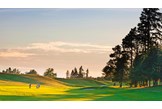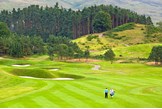5 keys holes at the Ryder Cup 2014
Published: Last updated:
When it comes to the Ryder Cup, every swale, dip, bank and curve offers the potential to elate a nation or devastate a continent. It’s no wonder every inch of this sporting theatre has been analysed to establish which necky tee shot or slightly heavy 8-iron could dash the dreams of millions. Since its 1993 inception as the Monarch’s course, the PGA Centenary at Gleneagles has seen more than its share of changes over the years. The course has been fundamentally revamped with original architect Jack Nicklaus overseeing the changes, which he describes here. Keeping up with the changes, never mind learning how to play them, is a challenge in itself.
But this is the Ryder Cup. Each hole represents an opportunity to claw back a deficit or move closer to victory. With so much at stake, who better to guide us through the pitfalls and possibilities than two men who know the PGA Centenary inside and out – head professional Andrew Jowett and caddiemaster Donald McLeod.
Jowett has played the course umpteen times with guests and dignitaries. He knows how far the pros can hit it and where they can score. Eight years at Gleneagles have taught him where the opportunities will be and what it takes to make them count. McLeod’s job is to ensure his clients survive the PGA Centenary course with their dignity intact. For him, it’s not about show-boating with a high draw or flirting with the water’s edge to please the crowd. He likes playing it smart by keeping it in the short stuff.
Here, these two aficionados take us through five of the PGA’s pivotal holes – all the par 5s and a driveable par 4 – to help us find out how the Ryder Cup could be won and lost.
 The 2nd
The 2nd
Wester Greenwalls, 516 yards, par 5
Donald McLeod: I would approach this hole by going down the right. There are two cuts of rough on the right, but there is more room than you can see from the tee, and the big hitters will still get home in two. If the wind’s right-to-left you can think about sending one round the corner, but I’d still keep it right and stay away from the bunker.
Andrew Jowett: The tee is set up for a right-to-left shot, so you are looking to set it off down the middle part of the fairway and turn it into the edge of that bunker. Anything left of that bunker, even if you carry it, won’t leave you a second shot to the green; you’ll have to take a wedge out and it becomes a three-shot par five. If you hit it round the bunker, you’ll have a slightly shorter second shot – you might be going in with a long iron instead of a hybrid or fairway wood. With water left and bunkers protecting the front left of the green, the ideal approach would be to land it on the right-hand side of the green.
 The 9th
The 9th
Crook o’ Moss, 618 yards, par 5
Donald McLeod: Even the longest should plan this hole as a three-shotter. Play short of the fairway bunkers, knock a long iron down to 100 yards short of the green. Knock it on and you have a chance of a four. If you go for it off the tee, the approach isn’t easy. You are left with a long shot, dog-legging round to the right, you’ve got water, you’ve got bunkers and the landing area short of the green isn’t big.
Andrew Jowett: It’s a typical Jack Nicklaus design in the fact you need to shape the ball off the tee. Here he’s looking for a fade – pick the two bunkers on the left and let the ball drift into the centre of the fairway. If you catch a good one, there is definitely a green light to go for it in two. If you make it, you can apply pressure. You don’t want to fall too far behind at this stage, but it is risk and reward. There is danger around the green with bunkers, swales and water. It’s also weather dependant. The wind tends to come in off the left and that will help you hit the required shape.
 The 14th
The 14th
Nebit Knowe, 320 yards, par 4
Donald McLeod: From a caddie’s point of view, I would never suggest going for it with a driver; it is just too risky. The safe shot is hitting 250 yards towards the bunker on the left, leaving yourself a wedge and a possible birdie. I am sure the big guys could knock it on with a 3-wood – Keegan Bradley pitched it straight into the bank behind the green and that was a 360-yard carry. But it’s a tough green to hit and hold. I’d suggest playing safe, but it depends on the state of the game.
Andrew Jowett: There are bunkers at the front and grass run-offs at the back, but the opportunity to go for it from the tee is just too tempting to turn down. It’s a small target as it has retained the original green from when it was a par 3, but it is almost built for matchplay. You can be aggressive or go safe. Anything down the right-hand side and there is some nasty cabbage and deep bunkers, so the left side gives you the safer play to the front of the green.
 The 16th
The 16th
Lochan Loup, 543 yards, par 5
Donald McLeod: It depends on the drive whether you go for it in two. It takes two very good shots to get to the green, so unless the player can get it level or past the fairway bunkers, the safe option is to play it as a par 5. It’s a very risky shot to go for the green – there’s a lot of water to go over. There is a bail out, but it’s wind-dependant. Into the wind, it’s just about out of range.
Andrew Jowett: It’s a genuine risk-and-reward par 5 that can be a real game-changer – at the Johnnie Walker we’ve seen eagles and double-bogeys. Aiming just inside the bunkers and turning it over a little right-to-left might squeeze you a little extra yardage and if you get over the saddle, you could get 15-20 yards extra. Anything short of that and you’ll be on the limit of reaching the green in two. For the top players the water won’t come into play, but they might play it down the left and fade it in over the bail-out zone. If they mishit, they’ll be dry and miss the front bunker.
 The 18th
The 18th
Dun Roamin’, 513 yards, par 5
Donald McLeod: Great hole, up the hill, round the corner. You’ve got to get a good tee shot away and keep it left of the bunker to give yourself a chance. You also don’t want to be short. If you’re not round the corner, you’re not going to get home in two. With run-offs left and right, it’s a difficult second shot, but if the pin is on the front and you’re going with a long iron, unless you hit the bank in front, you could look really silly. But the Ryder Cup is different to strokeplay and whether you’re one-down, one-up or all square will influence your strategy. The caddie will support the golfer, but ultimately it’s the golfer’s decision.
Andrew Jowett: One of the biggest redesigns. The tees have been lifted by just over eight metres which gives you the opportunity to get further up the hole making it a reachable par 5. Very much a risk-and-reward hole highlighted by the bunker on the corner of the dog-leg – you’ve got to keep it left of that. The second shot is a longish iron or a fairway wood into a small target. It’s reachable, but if you miss, there is no easy up-and-down. Depending on the state of the match, players may trust their wedge. It would, however, be a strong-minded player to hit wedge up and wedge on to make their four. If you’ve got the right kind of caddie, he might advise you to do just that. It will certainly test the partnership between player and caddie.






 The 2nd
The 2nd The 9th
The 9th The 14th
The 14th The 16th
The 16th The 18th
The 18th